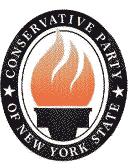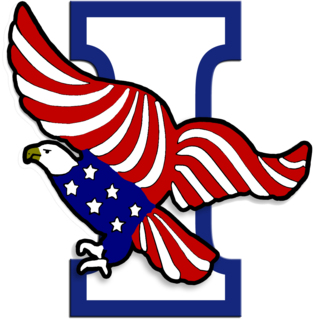Electoral fusion is an arrangement where two or more political parties on a ballot list the same candidate, pooling the votes for that candidate. It is distinct from the process of electoral alliances in that the political parties remain separately listed on the ballot. The practice of electoral fusion in jurisdictions where it exists allows minor parties to influence election results and policy by offering to endorse or nominate a major party's candidate.

George Elmer Pataki is an American lawyer and politician who served as the 53rd governor of New York from 1995 to 2006. An attorney by profession, Pataki was elected mayor of his hometown of Peekskill, New York, and went on to be elected to the State Assembly and the State Senate.
The Liberal Party of New York is a political party in New York. Its platform supports a standard set of socially liberal policies, including abortion rights, increased spending on education, and universal health care.

The Conservative Party of New York State is an American political party founded in 1962 following conservative dissatisfaction with the Republican Party in New York. Running on the Conservative Party line, James L. Buckley won election to the U.S. Senate in 1970 and served for one term. Since 2010, the party has held "Row C" on New York ballots—the third-place ballot position, directly below the Democratic and Republican parties—because it received the third-highest number of votes of any political party in the 2010, 2014 and 2018 New York gubernatorial elections. The party is known for its strategy of attempting to influence the Republican Party in a more conservative direction.

The 2006 New York gubernatorial election took place on November 7, 2006, to elect the governor and lieutenant governor of New York, concurrently with elections to the United States Senate in other states and elections to the United States House of Representatives and various state and local elections, then incumbent Republican governor George Pataki chose not to run for re-election in a fourth term. Democrat Eliot Spitzer, the New York Attorney General, won the election over former Republican state Assembly minority leader John Faso.

The Independence Party is a political party in the U.S. state of New York. The party was founded in 1991 by Dr. Gordon Black, Tom Golisano, and Laureen Oliver from Rochester, New York, and acquired ballot status in 1994. They lost their ballot status in 2020 under a change in the New York state election law that required at least 130,000 votes on the party line every two years. Although often associated with Ross Perot, as the party came to prominence in the wake of Perot's 1992 presidential campaign, it was created prior to Perot's run. In 2020, it affiliated with the Alliance Party, but disaffiliated in 2021. It used to have one elected member of the New York State Assembly, Fred Thiele, until Thiele switched his party affiliation to the Democratic Party in 2022.

The lieutenant governor of New York is a constitutional office in the executive branch of the Government of the State of New York. It is the second highest-ranking official in state government. The lieutenant governor is elected on a ticket with the governor for a four-year term. Official duties dictated to the lieutenant governor under the present New York Constitution are to serve as president of the state senate, serve as acting governor in the absence of the governor from the state or the disability of the governor, or to become governor in the event of the governor's death, resignation or removal from office via impeachment. Additional statutory duties of the lieutenant governor are to serve on the New York Court for the Trial of Impeachments, the State Defense Council, and on the board of trustees of the College of Environmental Science and Forestry. The lieutenant governor of New York is the highest-paid lieutenant governor in the country.

The 2006 United States Senate election in New York was held on November 7, 2006. Incumbent Democratic U.S. Senator Hillary Clinton won re-election to a second term in office, by a more than two-to-one margin. Clinton was challenged by Republican John Spencer, the former Mayor of Yonkers. Longtime political activist Howie Hawkins of the Green Party also ran a third-party campaign.

The Libertarian Party of New York (LPNY), is the affiliate of the Libertarian Party in the U.S. state of New York. Due to changes in New York State election law in 2020, the Libertarian Party lost its ballot status. It is the recognized affiliate of the national Libertarian Party.

The 2002 New York gubernatorial election was held on November 5, 2002. Republican Governor George Pataki was re-elected to a third term, defeating Democrat Carl McCall and Rochester billionaire Tom Golisano, who ran on the Independence Party line. As of 2022, this was the last time a Republican won a statewide election in New York, and the last time Albany, Tompkins and Westchester counties have voted Republican in a statewide election.

The 2010 South Carolina gubernatorial election took place on November 2, 2010. Incumbent Republican Governor Mark Sanford was term limited and unable to seek re-election. Primary elections took place on June 8, 2010, and a runoff election, as was necessary on the Republican side, was held two weeks later on June 22.

In New York State, to qualify for automatic ballot access, a party must have qualify every two years by receiving the greater 130,000 votes or 2% of the vote in the previous gubernatorial election or presidential election. In years with a gubernatorial election or presidential election a party must run a gubernatorial candidate or a presidential candidate to be eligible for automatic ballot access; if 130,000 voters vote for that candidate on their party line, they have qualified the party for the next two years until the following presidential or gubernatorial general election whichever one comes first. A party that is not qualified may run candidates by completing a petition process. Parties are also allowed to cross-endorse candidates, whose votes are accumulated under electoral fusion, but any parties must cross-endorse both the governor and lieutenant governor candidates for fusion to apply. Parties that are already qualified must issue a Wilson Pakula authorization if they cross-endorse someone not enrolled in that party; there are no restrictions on who can be nominated on a non-qualified ballot line, as these lines are determined by filing petitions.

The 1994 New York gubernatorial election was an election for the state governorship held on November 8, 1994. Incumbent Democratic Governor Mario Cuomo ran for a fourth term, but was defeated by Republican George Pataki in an upset victory. Pataki had previously been described by the New York Daily News as "a little-known Republican state senator." The conservative New York Post attributed the result to how voters "had grown tired of the 12-year incumbent Cuomo and his liberalism."

The 1990 New York gubernatorial election was held on November 6, 1990, to elect the Governor and Lieutenant Governor of New York. Democratic Governor Mario Cuomo won a third term in office, making him the first Democrat elected to three terms as Governor of New York since Herbert H. Lehman.

The 2014 New York gubernatorial election took place on November 4, 2014.

United States gubernatorial elections were held on November 7, 2017, in two states: Virginia and New Jersey. These elections formed part of the 2017 United States elections. The last regular gubernatorial elections for these two states were in 2013. Both incumbents were term-limited, so both seats were open. Democrats held the governorship in Virginia and picked up the governorship of New Jersey.

The 191st New York State Legislature, consisting of the New York State Senate and the New York State Assembly, met from January 4, 1995, to December 31, 1996, during the first and second years of George Pataki's governorship, in Albany.

The 2018 New York gubernatorial election occurred on November 6, 2018. Incumbent Democratic Governor Andrew Cuomo won re-election to a third term, defeating Republican Marc Molinaro and several minor party candidates. Cuomo received 59.6% of the vote to Molinaro's 36.2%.

The 2022 Connecticut gubernatorial election took place on November 8, 2022, to elect the governor of Connecticut. Incumbent Democratic Governor Ned Lamont ran for re-election to a second term in office. The race simultaneously took place with the election to the state's Class III Senate seat. This election featured a rematch of the previous 2018 gubernatorial election, pitting Lamont against Republican Bob Stefanowski, who he previously defeated by 3.2% of the vote. This time Lamont won re-election by a wider margin, becoming the first Democrat to win a gubernatorial election by more than 5 points in the state since 1986. This is the first time since 1994 that Tolland County voted Democratic in a gubernatorial election.

The New York City mayoral election of 1933 took place on November 7, 1933 in New York City. Incumbent Democratic Mayor John P. O'Brien, who was elected in a special election after the resignation of Mayor Jimmy Walker, faced Republican Congressman and 1929 mayoral candidate Fiorello La Guardia, and former acting mayor and President of the New York City Board of Aldermen Joseph V. McKee, who became acting mayor after Walker's resignation until the special election, and ran on the Recovery Party line.


















